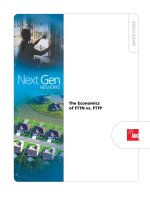Tài liệu The Economics of FTTN vs. FTTP doc
Bạn đang xem bản rút gọn của tài liệu. Xem và tải ngay bản đầy đủ của tài liệu tại đây (220.97 KB, 4 trang )
WHITE PAPER
The Economics
of FTTN vs. FTTP
The Economics of
FTTN vs. FTTP
There are three predominant schools of thought regarding how to meet the ever-
increasing bandwidth needs of consumers and businesses. Fiber-to-the-premise
(FTTP) architectures take optical fiber all the way to the home or office and offer
the most future-proof solution in terms of pure bandwidth capabilities. But in
some cases, FTTP may not be the optimal solution in terms of overall cost and the
value of existing infrastructure.
Fiber-to-the-node (FTTN) solutions offer operating companies an alternative
solution to providing the necessary bandwidth required by today’s voice, data, and
video services while taking advantage of existing infrastructure. In many cases,
FTTN can actually complement FTTP deployments. Finally, there is a fiber-to-the-
curb (FTTC) solution that boasts 80 Mbits/sec to the home. Certainly the question
surrounding this architecture is whether 80 Mbits/sec will be adequate and for
how long.
At the end of the day, the key consideration in choosing which architecture will
work best for any provider boils down to bandwidth – now and in the future. This
paper addresses several key considerations in helping service providers decide if
FTTN makes sense for all or part of their network.
For example, if a high percentage of a provider’s network is already designed using
digital loop carrier (DLC) remote terminals, it may make more sense to deploy FTTN
from an economic standpoint. Traditional telephone service providers seeking to
offer additional broadband services over an existing copper-based voice network
may find FTTN more advantageous and less costly than building a new network
that takes fiber all the way to the customer.
The Economics of FTTN vs. FTTP
Page 3
The business case
Every operating company must consider its own business
case in relation to the capabilities of the existing network.
Since an FTTN strategy seeks to leverage existing facilities
as much as possible, it will ultimately come down to
what each individual carrier sees as the real demand for
customer bandwidth – and where that demand will be five
to ten years from now.
Additionally, whether you choose FTTN or FTTC strategy as
an early alternative to FTTP for rapidly providing broadband
services to customers, it’s important to ensure network
longevity. Any solution should include an easy migration
path to FTTP if future bandwidth demands exhaust the
bandwidth capabilities of the current infrastructure.
Installation cost is always the primary concern in making
a business case for the network architecture. The FTTN
architecture will be less expensive to install than FTTP
because it re-uses legacy infrastructure for the final 3000
to 5000 feet. But, as stated earlier, installation costs alone
should not necessarily dictate choosing FTTN over FTTP,
particularly if the FTTN overbuild network will only provide
a five-year life in terms of bandwidth demand.
Service providers may find themselves in the position of
deciding which course of action is more prudent in the
long run – reaching customers ahead of competitors with
an FTTN overbuild that may require upgrades in a few
years, or spending more money for a new FTTP network
that will provide all the necessary bandwidth for years to
come. In other words, FTTN has the potential for faster
return on investment, yet it may require a complete
overhaul at some point – possibly sooner than later,
depending on consumer bandwidth demand.
Another consideration in choosing FTTN vs. FTTP depends
on how much of the network is rural and how much is
metro. An operating company can leverage FTTN in areas
with limited customers and lower entry costs in rural
areas, making broadband services available to customers
more quickly.
Bandwidth – how much is enough?
The biggest unknown in the broadband services equation
lies in how much bandwidth will be enough to support
video into the next decade. Will 50 Mbits/sec be enough?
80 Mbits/sec? 100 Mbits/sec? For the moment, MPEG4-
encoded high-definition television (HDTV) requires about
9-10 Mbits/sec, enabling consumers to receive four
HDTV stations from a 50-Mbits/sec asynchronous digital
subscriber line (ADSL) service. Without knowing content
requirements of the future and how much bandwidth
will be required to deliver new applications and services, a
limited service of 50 Mbits/sec could easily come up short
in just a few years.
Pair bonding can be used to produce higher bandwidth
capability from FTTN buildouts that use copper-based “last
mile” architectures. This technique enables the electronic
bonding, inside the DSLAM, of two output DSLAM ports
for providing twice the bandwidth to a single customer.
This requires the availability of two continuous copper
pairs to the customer premise. Also, the service delivery
platform, such as the cross box or interface, must support
the pair bonding.
There are other issues that must be considered to
successfully implement this technique. For example, this
technique requires using more of the DSLAM to serve
fewer customers. With that in mind, a 192-circuit DSLAM
may only be capable of handling 96 customers if multiple
HDTV services are demanded at each residence. Also, if the
distribution area requires resectionalization as reachable
distances decrease (for example, deploying VDSL will
require new cabinets for reaching customers outside a
3000-foot perimeter), the deployment of additional adjunct
DSLAMS may be necessary. Furthermore, if existing cross
boxes do not have the necessary binding posts to support
them, this initiative can quickly become very complicated
and expensive.
Another wildcard in making a decision between FTTN
and FTTP is in knowing what changes will occur in
active components over the next few years. As these
components improve, the bandwidth guessing game gets
more and more complicated. Where does this leave the
network architect?
Business cases must be determined by customer needs
today and the best determination of what they will need in
the future. An increasing demand for additional bandwidth
for cutting-edge broadband services seems like the one
thing everyone agrees on. But will the network upgrades
to provide that additional bandwidth be a simple matter
of swapping out a card at each end of the network? Will
it require a higher quality fiber plant to support high-end
services? Will factors like better forward error correction
techniques enable longer use of existing infrastructure?
Web Site: www.adc.com
From North America, Call Toll Free: 1-800-366-3891 • Outside of North America: +1-952-938-8080
Fax: +1-952-917-3237 • For a listing of ADC’s global sales office locations, please refer to our Web site.
ADC Telecommunications, Inc., P.O. Box 1101, Minneapolis, Minnesota USA 55440-1101
Specifications published here are current as of the date of publication of this document. Because we are continuously
improving our products, ADC reserves the right to change specifications without prior notice. At any time, you may
verify product specifications by contacting our headquarters office in Minneapolis. ADC Telecommunications, Inc.
views its patent portfolio as an important corporate asset and vigorously enforces its patents. Products or features
contained herein may be covered by one or more U.S. or foreign patents. An Equal Opportunity Employer
103826AE 5/07 Revision © 2006, 2007 ADC Telecommunications, Inc. All Rights Reserved
WHITE PAPER
The long and short of FTTN
FTTN offers several advantages over the short term to operating companies that want to be first in
reaching customers with today’s broadband services. Because it re-uses existing infrastructure to the
customer, turn-up can be achieved faster to meet immediate consumer demand. For the same reason,
FTTN is a less expensive overbuild and, therefore, will provide a faster return on investment, particularly in
many brownfield situations.
However, there are still many unanswered questions about bandwidth demand over the long term that
cannot be ignored. FTTN architectures will continue to have bandwidth limits that may be exceeded
– perhaps in five years or less. On the other hand, FTTP is certainly a more future-proof network design.
In greenfield models, there is no question it is the architecture of choice. It cannot be overstated that any
decision to deploy an FTTN overbuild network should include a solution that provides a relatively easy
migration to FTTP.
In the end, the final decision for FTTN boils down to current architecture and several considerations that
each operating company must resolve. Is it more advantageous to opt for an initial cost savings model with
faster return on investment? Can we depend on technology improvements that will allow us to avoid the
need to upgrade in the near future? Or is it more important, despite additional costs, to upgrade directly
to FTTP to ensure future-proofing the network against any future bandwidth demand?
There is no “one size fits all” solution when transforming the traditional switched approach network into
a high-speed, high-capacity broadband network. These are challenging days for any service provider – but
making decisions based on today’s information coupled with a concern for future events will help network
architects develop a solid business plan that meets each unique situation.
WHITE PAPER









